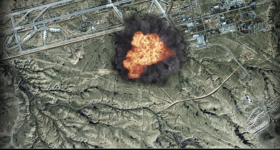 Andrew McKillop
Andrew McKillop
21st Century Wire
As the producers pump and financiers work their market magic, energy prices look to be on the move.
Fasten your seat belts. Time to take a hard look at the market…
Friday 24 January, as global stock markets and emerging market currencies took another hit, natural gas in the US – the world’s lowest priced gas – soared by 9.6% in a single day, rising to $5.18 per million British thermal units (MBTU) pricing it at $30.04 per barrel of oil equivalent at the Henry Hub. Over the week, prices gained close to 20%. US gas prices on Friday were at their highest since June 2010.
Related to the Emerging market exit panic and the US taper down threat, from the Fed buying $85 billion a month of “troubled debt and assets”, to a mere $75 billion a month, investors had to run somewhere. Starkly under-priced US natural gas was the weekly winner.
Reeling back the story to 2010, the last time US gas was priced at $30.04 per barrel of oil equivalent, compared to the “natural price of oil” at nearly $100 a barrel, the “shale gas revolution” had gone critical and was running riot. Today, the sequels are coming fast.
This was a no-holds-barred drilling frenzy with a linked land grab as drilling concession prices soared like something from a Thorsten Veblen tale of late-19th century capitalistic madness. Drilling concessions were changing hands of several thousand dollars per acre for multi-square-mile patches! The fracking boom was in overdrive. Gas output grew like Topsy. With no surprise at all, US gas prices suffered a historic collapse.

The gas was however locked up inside the US, with small pipeline capacities for exporting it out of the US, in fact only to Mexico. Canada was itself experiencing, or suffering the same “frack gas frenzy” making it a non-market for US gas at any price. The only logical solution was therefore LNG export to the vastly overpriced gas markets of Europe and Asia paying 2 – 3 times the US price, sometimes a lot more, but LNG terminals cost big money and take a long time to build.
Of course the prospect looked interesting, to say the least. In April 2012, when the Japanese were paying around $17 per MBTU for LNG from suppliers like Qatar, natural gas in the US hit a nearly 15-year low of $1.92 per MBTU. Predictions that the price would go to zero were of course to be found in the mainstream media, but by 24 January 2014 natural gas was up 170% from that historic low.
Volatile and Unreal Prices? Give Us More!
Like we know, US gas prices are volatile and were downward tilted, for years, while oil prices are still bludgeoned up, anytime they show weakness. So much for “transparent markets”, but the market volatility rationale however has its limits which are now close. US gas exports via pipeline to Mexico have grown, especially since additional pipeline capacity went into service last year and Mexico unsurprisingly switched increasing amounts of its power production, using its own oil, to cheap US natural gas.
In turn, Mexico can in theory export more of its oil – while oil remains overpriced – but the process connects with a thing called “the real world”. Even building gas-fired power plants (let alone LNG terminals) takes time.
Like the USA, Canada has stampeded into the all-new business of LNG terminals-on-paper. Exports are moving forward – in people’s heads. Government and bureaucracy have invited themselves to the party adding another layer of time, and costs, to maybe building terminals – some day. Now we can add the potential and possible threat that US gas prices edge back up to say only one-half the oil price on an energy price basis – and we can be rather sure LNG terminal dreaming may terminate itself, almost before any of them are built at a price tag of billions each! The US already has some, if only a few LNG import terminals, built on the bet that US gas prices would stay high. Converting them to export terminals is not cheap.
Hyper low US gas prices, and the opposite in Europe and Asia, together with overpriced oil everywhere have had a swath of impacts – expected, unexpected, short-term, mid-term and even economic-structural. Almost none of them are either rational or useful.
Extreme effects have for example included the energy market maker banks in the US, at least until nabbed by the US FERC regulatory agency, switching electricity generated from coal-fired plants to the same utilities’ gas-fired plants, either on paper or with help from the utilities in the real world. Also, a swath of US utilities have simply gone out and scrapped, not mothballed, their oldest and most inefficient, most polluting coal-fired power plants. In some cases in the US, but a veritable plague in Europe, the new gas-fired plants have to compete with windfarms and solar power plants, some days and some hours of the day. Gas-fired plants’ economic performance often compares badly with the paper promises and projections.
Also, large global-oriented petrochemicals producers have started building plants in the US to use cheap natural gas as feedstock. What do they do if gas prices move back up? Also, the long-announced but always shy natural gas revolution in road transport has begun to show some signs of real world life. Gas demand is picking up, or can pick up! Prices can now be driven up.
On the other end of the gas pipeline however – for gas producers – ultra cheap US gas was a disaster for many gas drilling companies. Thousands of unprofitable wells litter the land, with producers “keeping going and hoping”, while others do not have that luxury. Billions of dollars were written off due to the land grab-drilling concession price frenzy. Real money invested in fake drilling permits and in pipelines that were never built during the US frack gas boom period – that we can date at about 2006-2012, has disappeared into the ground and into thin air where more and more gas is simply flared or vented.
What happened to ‘Drill Baby Drill’?
Boom-slump means investors lured with false promises. In the physical and real gas industry, the bloodletting was epic, like something from Thorsten Veblen. Making the financial roller coaster even more ridiculous in its effects, shale gas wells are particular in having sharp decline rates. New wells need to be drilled constantly to make up for the decline in older wells. If the “dry gas” price is ridiculously low and there is no “wet gas” to offset the costs through recoverable natural gas liquids and oil in the gas, the wells aren’t drilled.
Industry restructuring now includes a clear movement from “dry gas” exploration and production, to any “wet gas” field or prospect. Dry natural gas is now something of a by-product. Often it is simply flared, as in the “bad old days” for major oil provinces like the North Sea, when gas was cheap or worthless. The highly productive Bakken shale-oil field in North Dakota, Montana and southern Saskatchewan now has a general rule whereby if dry gas is the only find, it is flared. Around 30% of the field’s total gas output is either burned at the wellhead or vented to the atmosphere as a waste product. As in the North Sea and most other “oil-only” provinces of the past, and present, the low price of gas does not justify building pipelines to haul it away.
What about the pipelines?
So the pipelines were not built. As a very simple result, but not evident to the average “well-briefed market player”, it seems, not enough wells are being drilled. Production in all shale gas plays combined – except for the Marcellus shale region of the NE – is already either stagnant or slightly declining. Hence gas prices have to rebound. Market players can be counted on to turn that into an explosion.
Drilling monitors like the Baker Hughes company note that even in the Marcellus Field, the number of active rigs is down from its peaks in 2012. The decline in this case, like the others has been propelled by the gas pipelines on paper which were never built, to haul the gas away. Estimates suggest that several thousand gas-only wells in the Marcellus are presently shut-in, forming a kind of giant reservoir waiting for the happy day when the gas can be moved away.
We can add another hypothesis. The long-awaited, often-announced fall in the price of US and international oil to a possible “market rational” price level around $70 a barrel. Unless gas prices go exactly the opposite way, net and clear decline in US shale gas production is a real prospect. Overpriced oil will no longer cross-subsidize underpriced gas. So gas prices will have to soar.
All kinds of other neglected or ignored factor and drivers make for a forecast of US gas prices taking a leaf out of the gold price book – and only growing while other financial assets bite the dust. Due to the frack gas boom and ever-rising gas production at near double digit annual percentage rates through about 2008-2011, gas storage “became a thing of the past”. Add in a polar vortex cold snap able to freeze Niagara Falls, and US gas storage levels in mid-January 2014 were at an unsurprising all-time low since January 2005. When US gas changed hands at about $13 per MBTU.
Squeeze Baby Squeeze – The Natural Gas Squeeze
Exactly the same gung-ho speculative fever that Thorsten Veblen described, which slayed US gas prices over 6 years and drove them to near-zero can “seamlessly” run the other way. US gas prices before the fracking boom could on occasions top $15 per MBTU, which for Japanese is cheap gas but today can be a nice target price for the speculators.
Writing on his blog Testosteronepit, Wolf Richter said this week that betting on US and world gas prices is sometimes only a bet on the weather. To be sure he also added “You also bet on….market manipulation and the limitless availability of money from yield-chasing investors whose billions (will) fund years of over-drilling, which then crushes prices – and the financial models of these wells. Billions in mal-investment (will) get written off”.
And somebody has to pay for the gigantic waste – the consumer.
If its cold, prices will be up. Talk about polar vortices has a dollars and cents handle for gas prices. Decorative frills are added by analysts to get the gung ho speculative boom on the rails, for example: “Strong demand is expected to push gas inventories to very low levels with cold weather lingering”. Later on we can hear about the pipelines on paper that weren’t built, and the sterling role of natural gas in “fighting” climate change and global warming. Anything will do for the snake oil crowd working their snake-gas act!
US natural gas prices, unlike US and world oil prices are not rigged in New York, but in Houston. The very few, rich and renowned (to market players) natural gas market maker funds have carved themselves a reputation for jagged-profile gas prices. US natural gas is famous for its price spikes, unexpected plunges when it should rise, and inexplicable rises when it should drop. Whenever its not a bet on the weather, its a bet on how a few Houston funds want the price to move – like guessing what Goldman Sachs wants as the oil price in New York, today. For the moment, any high price will do.
What counts is that a natural gas squeeze and “wild prices for US gas” are most certainly possible.
Obligatorily this has nothing at all to do with gas reserves, production or demand. World gas reserves are at multi-decade highs. Production is increasing rapidly. Gas transport capacities, both pipeline and LNG are growing rapidly. On a worldwide basis, gas demand is rising although certainly not runaway growth-style.
When or if a gas squeeze can be engineered, paper-only will suffice, the breakout of US gas prices will be possible.
READ MORE FROM THIS AUTHOR AT: 21st Century Wire McKillop File














